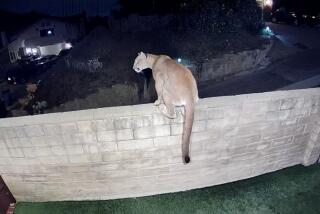‘Animal Land’ art project puts vanishing native species in perspective
Imagine you’re walking downtown at night, you turn a corner and you see two 30-foot-high apparitions of bright, white vultures spreading their wings above a vintage VW bus.
That feeling — a sense that the wild birds, or you, are a bit out of place — is the message that Phoenix artists Lauren Strohacker and Kendra Sollars are trying to convey with “Animal Land.”
See more of Entertainment’s top stories on Facebook >>
Their collaborative project consists of large-format video projections of indigenous species in manufactured environments. It’s a visual metaphor responding to the displacement of animals from their natural habitat because of urban sprawl and wildlife management.
Environmental artist Strohacker had worked on projects with wildlife groups, installing life-size Mexican wolf silhouettes on buildings in Tucson and a herd of reflective mule deer statues in a vacant lot in Phoenix. After seeing her silhouette in motion while mountain biking through Paradise Valley at night, she realized projection was the way to simulate animals’ movements more realistically.
She recruited video installation artist and fellow Ohio State graduate Sollars. With her background as a competitive synchronized swimmer and Cirque du Soleil performer, Sollars choreographed the animal compositions.
“The projection appears as pairs, but they are actually a single animal,” said Sollars, who edits footage filmed at three local wildlife centers into a presentation that runs from 30 minutes to six hours.
“The project initially began as a rogue-style pop-up project,” Sollars said. “We’d pick an outdoor space, throw up the projection for an hour and see what happens.”
Galleries took notice with indoor exhibitions at the Phoenix Art Museum, the Mesa Arts Center and the Tucson Museum of Art. In Los Angeles, Strohacker and Sollars are scheduled to speak March 10 at Skylight Studios as part of the Annenberg Space for Photography’s “Iris Nights Lecture Series.”
“Whatever space or city we’re in, we try to use animals native to the area. It’s very site-specific,” said Strohacker, noting a commission with great horned owls in Scottsdale.
“It’s interesting to see how many people don’t recognize native species,” she added. “It really plays into that ecological loss of information.”
She cited prairie dogs, which are common in Arizona. “A lady walked by the installation and said, ‘Look at those cats!’”
More to Read
The biggest entertainment stories
Get our big stories about Hollywood, film, television, music, arts, culture and more right in your inbox as soon as they publish.
You may occasionally receive promotional content from the Los Angeles Times.










